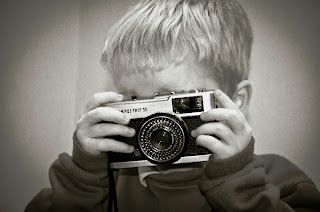 |
| This photography lark is child's play! |
A couple of weeks ago I bought myself a new toy. Well, when I say new toy I actually mean it’s
about 35 years old.
Going back to shooting on film has inspired me a great deal
and I’m really enjoying it at the moment. However, as with digital SLR’s, I sometimes
don’t want to carry around a big load of gear. The answer to this, in both formats is a
compact camera. Of course there are
issues with these. Both can have poor
glass, both can be frustratingly slow and unless you get a really expensive one
both can be very inferior to their SLR equivalent.
The obvious answer to this in the digital world is a Compact
System Camera (CSC). In the film world
it was a rangefinder.
The ideal camera would be a Leica M3 but even second hand
these go for somewhere in the region of £1000 just for the body. Definitely out of my price league!
I began reading some articles about street photography and
film cameras and one model kept cropping up. It was Olympus Trip 35.
Production of this camera began in 1967 and finally ended in
1984 after over 10 million cameras had been sold. The camera became famous due to its 1970’s
marketing campaign featuring David Bailey.
The camera was aimed at the burgeoning traveller/tourist
market and it same perfectly designed for this.
The most notable aspect of the camera is a selenium light
meter that allows the camera to set its shutter speed. This particular light meter also meant that
the camera did not require batteries, a very useful feature to consider when
travelling to remote places.
The camera is also semi-automatic and works pretty much like
the program mode of modern digital cameras. You set the focus via the zone focusing ring
on the lens. You have the options of
single person portrait, two person portrait, group shot or landscape. With the aperture ring set at ‘A’ you then
look through the view finder and shoot. The aperture ring can be over ridden but to be
honest, you could be asking for trouble if you didn’t know what you were doing.
The reason for this is that the Trip 35
has only two shutter speeds. They are
1/40th and 1/200th of a second.
The camera can take a variety of films raging from an ASA
(now ISO) of 25 – 400. This meant you
could use a wide range of films including the now iconic Kodak Tri-X which was
rated at ASA 400. Earlier models had a
maximum ASA of 200.
I have to admit, first use of the camera has left me
impressed. It’s nice to hold, light and
very simple to use. I’ve just shot a
roll of Ilford HP5 through it and I’m now waiting to process it, once done, I
will post some scans.
While I was shooting with it, I thought I would try some
street photography and this camera is perfect for it. You have to be relatively close to your
subject due to the 40mm lens but isn’t that the whole point of street
photography? However, that camera is so
small and unassuming that it isn’t at all offensive to people and often goes
unnoticed.
My little boy also likes this camera and to be honest, it is
an ideal camera for him to start with. I
may have to buy another one, just for him!




